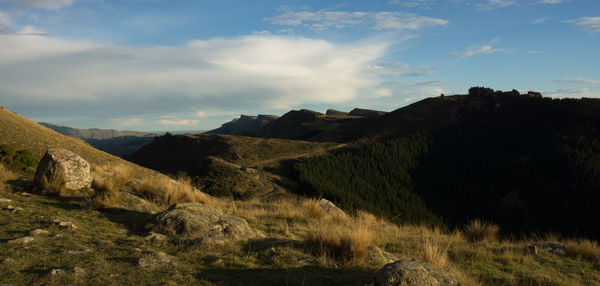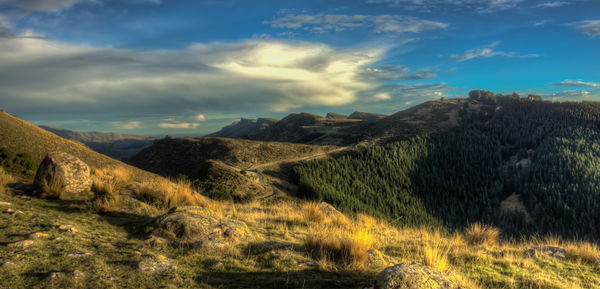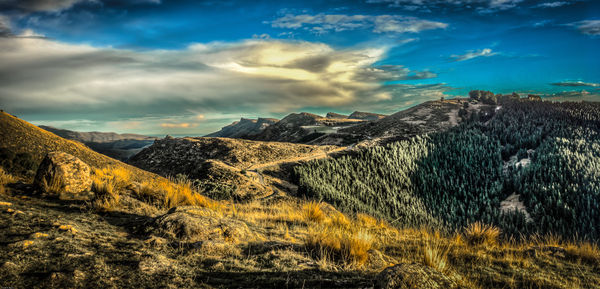HDR Progression
Jun 3, 2013 01:06:16 #
I'm going to post 3 photos here the first is the original correct exposure of a 3 photo bracket the next will be the original Hdr with some pp in Lightroom and then the last is the second image treated with one of Trey Radcliffe's presets: HDR in Lightroom - Flatjack and then some more PP in lightroom to tone it down a bit. I like it! I find that it really pays to approach HDR with an open mind that way when I push the envelope I can sometimes surprise myself although I did create the final image @ about 1.30am this morning.
your comments will appreciated just remember there is no right and wrong here just what gets you going
your comments will appreciated just remember there is no right and wrong here just what gets you going
Original "correct exposure" from 3 shot bracket

HDR original

Radical HDR

Jun 3, 2013 08:43:06 #
andrew.haysom
Loc: Melbourne, Australia
My preference is the second one, it looks very natural but really pops. Great work.
Jun 3, 2013 08:55:33 #
'Just remember there is no right and wrong here, just what you gets you going.' In part I agree with what you are saying if the emphasis is to experiment and allow your creativity to lead you down different roads. And I agree about the need for open mindedness, not just with HDR but in all art forms. But I am a little wary of the exclusion of all right and wrong, particularly when it comes to errors and failings in technique. For some (and I am most certainly not implying that this is the case for you) the 'yes but I like it that way' response can be a barrier to artistic growth and skill development. Let me explain with a simple example. If I say create a seascape which I expose well and include interesting elements etc but I fail to correct a sloping horizon, that slope detracts from the pic, it is clearly a mistake, ie it is wrong. Now I am not suggesting that there are never occasions where a sloping horizon could be used for creative effect but such a use, would I suggest, feel integral to the picture as a whole, viewers may or may not like it, it may challenge them artistically but it would not stand out as being a mistake.
So to your pics. If we look at your second pic then there is no doubt that the HDR process has brought out details that were not there in the first pic. There are still two fairly dark areas with potential detail to be brought out and the sun and the front couple of grass clumps have been pushed until it they are borderline blown. There is also a general softness about the pic. If you had left the pic as it was then you have an excellent result. And even though I and maybe others would suggest that the pic could be improved by sharpening, by tweeking the contrast and brightness, particularly to draw the eye further into the pic these are partly subjective responses and could in no way be regarded as attending to something in your pic which is 'wrong.' Interestingly these seem to be largely the areas you have worked on to produce the final pic so I have not said anything so far which is much different to what you tackled.
In my opinion the final pic is an improvement on the second. You have opened up the shadows beautifully. You have lightened the full length of the road and the small plateau at the back so that your eye is lead into the pic. And you have brought out the colours in such a way as encourage the exploration of the details well into the background. In many ways very successful processing. But as a consequence of that processing you have also introduced artifacts and noise into the area of sky above the hills on the right and in the white cloud in front of the sun. The two clumps of grass at the front are now completely blown as you have lost the details of the stalks. And you have introduced a thin very light halo over the hills from the right to three quarters of the way to the left. Clearly these three do not integrate with the pic as a whole, and therefore fit into the category of technical errors. They are not terminal and can be fixed with a little more work but at the moment they detract because they don't fit the rest of the pic. So I would suggest that in the end it does come down to right and wrong. There is a lot that is right in this pic, not just because I like it (and a I do, I like it a lot) but because the end product corresponds to your artistic vision, you got it to look how you wanted it. It was what got you going. But I would equally argue that the three areas I have pointed out are wrong, not because I don't like them (and I don't but they may not bother others as much) but they are wrong because they do not correspond to your artistic vision. I am certain you worked on this pic intending bring out all the wonderful details and colours that you have found but equally I am certain that it was not your intention to introduce artefacts in the sky or burn out the front grass clumps etc. they just happened along the way.
In case you haven't figured out by now I really like what you have done with this pic. For me it really shows up what HDR is all about. But to lift your work to the level which I believe you are capable then its attention to all of the details, mastery of the software, and never being satisfied until everything is right. I once heard Marco Pierre White say that the way to cook a perfect meal is to prepare and cook every single component perfectly along the way. Its the same with photography.
I hope this helps. I am really enjoying you work and I look forward to seeing more.
Peter
So to your pics. If we look at your second pic then there is no doubt that the HDR process has brought out details that were not there in the first pic. There are still two fairly dark areas with potential detail to be brought out and the sun and the front couple of grass clumps have been pushed until it they are borderline blown. There is also a general softness about the pic. If you had left the pic as it was then you have an excellent result. And even though I and maybe others would suggest that the pic could be improved by sharpening, by tweeking the contrast and brightness, particularly to draw the eye further into the pic these are partly subjective responses and could in no way be regarded as attending to something in your pic which is 'wrong.' Interestingly these seem to be largely the areas you have worked on to produce the final pic so I have not said anything so far which is much different to what you tackled.
In my opinion the final pic is an improvement on the second. You have opened up the shadows beautifully. You have lightened the full length of the road and the small plateau at the back so that your eye is lead into the pic. And you have brought out the colours in such a way as encourage the exploration of the details well into the background. In many ways very successful processing. But as a consequence of that processing you have also introduced artifacts and noise into the area of sky above the hills on the right and in the white cloud in front of the sun. The two clumps of grass at the front are now completely blown as you have lost the details of the stalks. And you have introduced a thin very light halo over the hills from the right to three quarters of the way to the left. Clearly these three do not integrate with the pic as a whole, and therefore fit into the category of technical errors. They are not terminal and can be fixed with a little more work but at the moment they detract because they don't fit the rest of the pic. So I would suggest that in the end it does come down to right and wrong. There is a lot that is right in this pic, not just because I like it (and a I do, I like it a lot) but because the end product corresponds to your artistic vision, you got it to look how you wanted it. It was what got you going. But I would equally argue that the three areas I have pointed out are wrong, not because I don't like them (and I don't but they may not bother others as much) but they are wrong because they do not correspond to your artistic vision. I am certain you worked on this pic intending bring out all the wonderful details and colours that you have found but equally I am certain that it was not your intention to introduce artefacts in the sky or burn out the front grass clumps etc. they just happened along the way.
In case you haven't figured out by now I really like what you have done with this pic. For me it really shows up what HDR is all about. But to lift your work to the level which I believe you are capable then its attention to all of the details, mastery of the software, and never being satisfied until everything is right. I once heard Marco Pierre White say that the way to cook a perfect meal is to prepare and cook every single component perfectly along the way. Its the same with photography.
I hope this helps. I am really enjoying you work and I look forward to seeing more.
Peter
Jun 3, 2013 18:22:55 #
Thankyou Peter for your excellent critique, I am quite new to HDR indeed new to digital photography! So I am still very much in the experimental stage getting to know the software (Photomatics Pro & Lightroom4) and I really appreciate your comments. So how do I reduce the noise in the sky as this is something I have been struggling with and also the halo along the skyline, I know halos are something I need to work on too. I think that the blown highlights in the grass don't really detract that much from the image although I appreciate what you are saying.
By right and wrong I am really alluding to the natural look verses the really processed look and it is fine to have an opinion either way and yes sometimes the really processed images are wrong (which probably means there is more processing needed to get the balance right) however if one closes their mind and says that natural is the only way to go or vice versa then that becomes too limiting and we shut our selves off from a whole area of creativity that is open to us if we really want to expand our horizons.
Question!
Should one remove the background PP that Lr4 does to images when they are loaded into Lr4 before exporting them into Photomatics?
Alan
By right and wrong I am really alluding to the natural look verses the really processed look and it is fine to have an opinion either way and yes sometimes the really processed images are wrong (which probably means there is more processing needed to get the balance right) however if one closes their mind and says that natural is the only way to go or vice versa then that becomes too limiting and we shut our selves off from a whole area of creativity that is open to us if we really want to expand our horizons.
Question!
Should one remove the background PP that Lr4 does to images when they are loaded into Lr4 before exporting them into Photomatics?
Alan
Jun 4, 2013 04:31:45 #
altheman wrote:
Thankyou Peter for your excellent critique, I am q... (show quote)
I just reread your initial post and realised that although like you I use Photomatix, I use PS and not LR with which I am not very familiar at all, but there are others here who use it and will be able to give you guidance. But I may be able to help out with Photomatix because it is by getting the Photomatix settings right that you largely avoid the noise/artifact, halo and burn out problems. Firstly, as a general principle, I think it is better to err on the side of natural in you initial processing in Photomatix as much of the 'HDR feel' is brought out in later PP. If you push for too much 'HDRness' when you are first merging in Photomatix you have no easy way of pulling it back in later PP if you need to. (There actually is a way but it is fiddly.)
Firstly when you take the pics into HDR you have the option of noise reduction right at the beginning. I usually don't use noise reduction at this stage as I don't want to lose detail, but Andrew suggested setting it for noise reduction only on the correctly exposed and the underexposed shots which I have tried and I can sometimes see benefit. Try it and see. The 4 main adjustments which seem to most influence the 'HDRness' of a pic are Strength, Smooth Highlights, Micro Smoothing and Lighting Adjustments. But they are also the adjustments which are likely to produce problems so its a balancing act. I tend to keep the Strength set at 100 and rarely move it. I click the Lighting Effects box and select either Natural or Medium. I prefer Medium but this can introduce or strengthen halos so Natural is the fall back. Micro Smoothing and Smooth Highlights really interact with each other and the pic as a whole. Generally the further to the left they are set the grungier the effect. I would suggest that much of the noise/artifact that you have in the sky for your pic is probably the result in part of the Micro Smoothing slider being set too far to the left. So as I said go initially for a fairly natural look but with the a hint of HDRness that you may want but not so that it introduces defects. Defintely do not accept any blown areas or completely black areas even if it means that you have to reduce the HDR feeling, you can bring that out later. But you cannot bring back burnt out highlights or completely crushed blacks. As for halos it is inevitable that they will turn up at some stage but again Micro Smoothing and Smooth Highlights can often be adjusted to tackle this. Interestingly adjusting the Gamma and Shadows Smoothness can also reduce halos on occasions. If you are stuck with some amount of stubborn halo this can be removed later in PP. (There is a FAQ about removing halo artifacts in the FAQ section of UHH but this is written for PS and Elements so I am not sure how it works in Lightroom. But others will.)
I am in complete agreement with you about the need to include a range of HDR styles. Personally I tend to towards the natural but at times, I veer towards grunge, it depends on the subject matter. But whatever the final effect that I am after I always use Photomatix conservatively, I give it a flavour of what I am after, then bring it out in PP. You mentioned Trey Radcliff's work which is a fantastic place to start. You will see that he uses Topaz Adjust in some of his work when he is doing PP after Photomatix. I would strongly recommend this piece of relatively cheap software as an excellent way to bring out the characteristics that you are after in your HDR pics. After Photomatix and PS, it is my favourite piece of software.
Hope this helps. Keep posting there are lots of good people here who will help and if you want to know anything just ask.
Peter
Jun 4, 2013 04:58:56 #
andrew.haysom
Loc: Melbourne, Australia
I would echo Peter's endorsement of the Topaz products. I too like Adjust and use it often. I've also been impressed with the recently released Clarity product as well, although as I've only had it a week, experience is limited. I also love Denoise which I think does a much more effective job of removing noise without damaging detail as much as some other tools.
Jun 4, 2013 07:56:51 #
normally i would go with #2 but in this case i like the pop in #3.
Jun 4, 2013 08:53:08 #
Thanks Guys for your comments. Tomorrow I am picking up a new lens (10-18mm eMount zoom for my NEX7) so new software will have to wait till the bank account recovers
Jun 5, 2013 21:47:41 #
Jun 11, 2013 07:24:51 #
joe west wrote:
I agree, I like #3 best because it has an Artistic/hand painted feel to it past the "natural" HDR ,most seem to aim fornumber 3 looks really good, kinda makes it pop
If you want to reply, then register here. Registration is free and your account is created instantly, so you can post right away.



